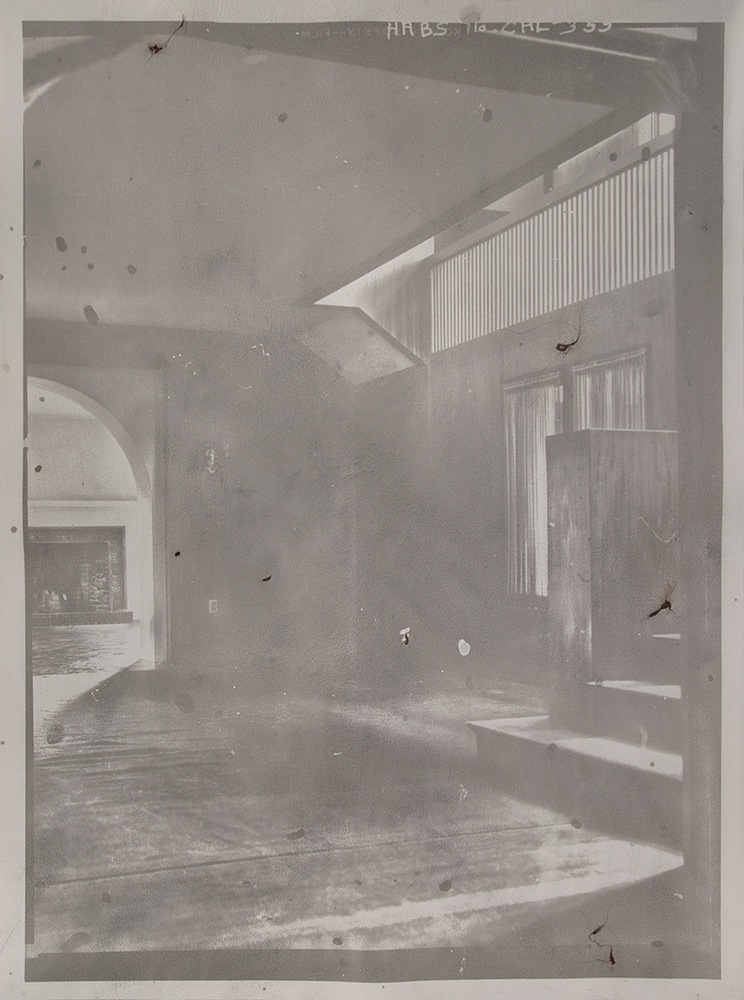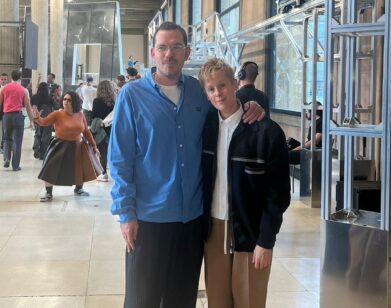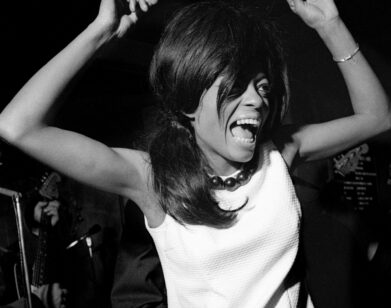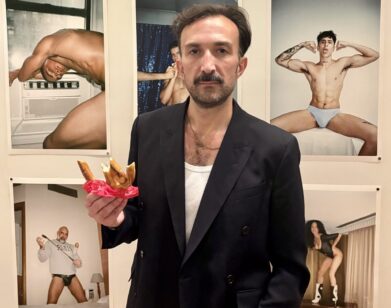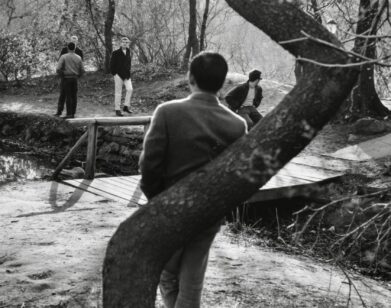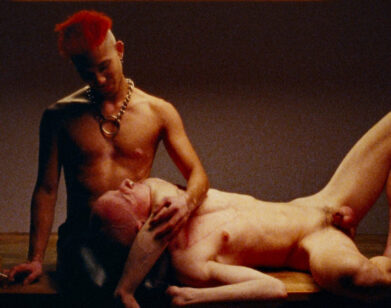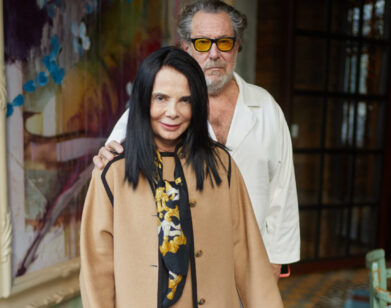Matthew Brandt and A Handful of Dust
Discovering hundreds of dead honeybees on a California beach would be an unlucky omen for most, but for Los Angeles photographer Matthew Brandt, it was a sign to return to the studio, honeybees in tow. The result: a set of gum-bichromate prints that literally placed his subjects into the picture. “Photography’s always been an unruly medium based on experimentation and playing with process,” says curator Catherine Evans, who organized “Sticky/Dusty/Wet,” Brandt’s first one-person museum exhibition opening today at the Columbus Museum of Art in Ohio. “But the more I know about Matthew’s work, the more complex and fascinating it becomes, both exuberant and steeped in history.”
In another set of images on view at CMA, Brandt again incorporates the physical world, soaking landscapes with the water of the lakes and reservoirs he photographed to produce liquid hallucinations awash in psychedelic hues of electric violet and acid yellow. “Visually stunning and stylistically diverse,” notes Evans, “each series has its own perceptual handle.”
Across the pond at Paris Photo (on through November 17), the artist’s L.A. gallery, M+B, has been briskly selling new work from its booth at the Grand Palais, including a variation on Brandt’s architectural photographs comprised of collected dust. His latest iterations resurrect Irving Gill’s Dodge House—a midcentury West Hollywood landmark demolished in 1970—in a fine film of soot from the apartments that replaced it.
Next month, M+B will stage its own solo show for Brandt, “Stars, Dust, Bubble Wrap,” marking a move towards the figurative with his series of silkscreened-velvet bodies. In January, the Cooper Union and UCLA-trained 31-year-old will share wall space with Gerhard Richter, James Welling, Marco Breuer, and Alison Rossiter in “What is a Photograph?” at New York’s International Center of Photography.
With a few minutes to spare before dashing off to see another one of his pieces at the Palais de Tokyo, the easygoing Californian spoke from Paris about his process and what he’s up to next.
JULIE BRAMOWITZ: How’s Paris?
MATTHEW BRANDT: I got in yesterday. I’ve caught up with jetlag, so I’m not too sleepy, but I just did have a glass of wine. I saw Pierre Huyghe’s show at the Pompidou, which is amazing. I did some cheesy stuff, too. I’ve been here before but I’m with my girlfriend, so we saw the Eiffel Tower, the Champs-Élysées, all that stuff. We couldn’t resist. I kind of want to get back to L.A. because there’s a show a coming up and still a lot of work to do. But this is a nice little break.
BRAMOWITZ: Do you ever work on the road?
BRANDT: A lot of the photographing is on the road. Usually a project stems from when I’ll go to a place and get interested in something. Being out of the city, that’s where you gather material to work with, and then you bring it to the studio and chisel it out or massage it into something. I did gather a bunch of dust from Chicago.
BRAMOWITZ: Could you explain?
BRANDT: For the “Dust” series, I’ve been collecting pictures from public libraries around the United States, focusing in particular on buildings that have been demolished. Then I search the images and get the rights to use them. I go to the site where it exists now, which is usually something different, a newer establishment like a Whole Foods. I’ll sweep the location, collecting dust and making gum-bichromate prints of the old photographs with what’s been swept from the place that’s there now.
BRAMOWITZ: How much dust do you collect for one image?
BRANDT: Actually, you don’t need that much. You’d be surprised. To make something that has some sort of pigment doesn’t require tons of dust. An eighth of a Ziploc bag is enough for a big print. And it’s pretty easy to collect dust. Even places that look really clean, once you start sweeping, it’s there.
BRAMOWITZ: My apartment might be a good place to start.
BRANDT: Yeah, exactly. Like, “I’d like to commission a piece. Don’t forget under the bed.”
BRAMOWITZ: I was intrigued by some of the other materials listed on the press release for your upcoming gallery show at M+B, including hair dye and torsos.
BRANDT: Oh, yeah. [laughs] The show that I’m working on now for M+B was loosely about gathering materials from where my studio is in Hollywood. What led to that in a lot of ways was working with velvet. Trying to make velvet pictures because I like the inherent baggage that velvet painting comes with, like kitschy, Velvet Elvis. Those kinds of connotations. Doing some other pieces out of velvet, I learned about this burn-out process. What I’ve been doing is silk-screening this acid material on the velvet and it eats away or carbonizes it, and then you have to wash it off and do a process to get rid of that. What’s left are some recessed cavities, so it’s sort of like taking away the picture.
BRAMOWITZ: How did you choose the torsos in your velvet burn-out photos?
BRANDT: They’re just people that I’ve been interacting with in the area. One is someone who helps me at the studio, one of them is my dad, and one of them is someone I don’t know. But usually it’s like, “Hey, you’ve got a striped shirt on. Can I take a picture of your shirt?” And it’s pretty straightforward. There’s not an overarching theme, like, “These are all people with the name John.”
BRAMOWITZ: As a Los Angeles native, have you always been interested in Hollywood kitsch?
BRANDT: Yeah, I think it’s embedded in my psyche. The studio that I have now was my dad’s and then in the past five or so years I took it over from him. He’s been the longest tenant there. Maybe 27 years. He’s a commercial photographer, so I grew up working in the studio, sort of being his assistant on these big photo jobs. I’ve never consciously thought about it, but just being in Hollywood, seeing the underbelly of how things are made, seeing the ad afterwards, I’m sure it’s influenced the way I think about image making. There’s always a certain level of presentation and packaging. Making pictures in Hollywood sounds like such a cheesy cliché and it’s sort of funny to say that. But sometimes I get a little embarrassed.
BRAMOWITZ: Did you start taking photos as a child?
BRANDT: I don’t think I took pictures or even took photography seriously until probably halfway into school at Cooper Union. My portfolio for Cooper was just all drawing and painting. Even when I would be working as my dad’s assistant, people would ask, “Are you going to be a photographer when you grow up?” and I was like “No way.” I always thought of photography as a trade.
BRAMOWITZ: So what changed?
BRANDT: I started looking at a lot of artists who have used photography, educating myself on the history of photography and its relation to art. I also naturally had a knack for it because I understood F-stops and speeds and strobes from working for my dad, who would get mad at me if I didn’t do something right.
BRAMOWITZ: While you were still at art school, who were some of the artists whose work changed your ideas about the medium?
BRANDT: One person who really influenced the way I think about photography was Walid Raad, who I studied with at Cooper. He creates a whole context for making photographs, giving a reason for the photograph to exist. It’s just really beautiful work exploring the ambiguities of the civil war in Lebanon. Studying with Hans Haacke at Cooper really influenced me because there’s a different dialogue when you’re not talking about dodging and burning. I would bring a photograph in and rather than saying, “It’s pretty and it does this and that,” you’re backing up, asking “Why is this a photograph? Why does this even exist?”
BRAMOWITZ: Back to the dust pictures. There’s something haunted and noir-ish about them.
BRANDT: The very first dust photographs I was took were all four sides of these corporate structures. I don’t know if you have them in New York, but they’re pretty prevalent in the San Diego area. They look like a big rectangle but with one-way mirrors that sort of reflect the landscape. In theory they’re supposed to keep out sunlight and be temperature controlled, but it’s this kind of creepy panopticon situation where they can see you but you can’t see them.
BRAMOWITZ: You said you don’t need that much dust to make a dust picture, but on average, how long does it take to produce a piece?
BRANDT: I get that question a lot. I never have a good idea right then and there, and I work more inductively versus deductively, if that makes sense. You learn the technique, but then you start to play around with the material. For instance, I printed pictures of trees out of trees and to do everything, to make paper out of wood, the burning of charcoal for the pigment, that project dated three years. Usually the material will end up very different once I get my hands dirty. But on a basic technical level, it’s probably about a couple days to print a dust photo. There are a lot of steps, but I’ve gotten pretty good at them. I know where I can cheat and where I can’t.
BRAMOWITZ: Do you always use the same camera?
BRANDT: No, it’s all different. I’m sort of embarrassed to say but I just got the new iPhone and most of those velvets were done with the iPhone camera.
BRAMOWITZ: Since you used to work on his sets, does your dad now have input about what you’re doing?
BRANDT: Definitely. He’s very helpful because he has ideas of beauty, which I think I sometimes neglect. I’ll think too much about the idea and get lost in it. In a way he does help me think about the final outcome. He’s very much of a formalist, so he wants to see the beautiful, crisp, black—you know, like the zoning theory in the black-and-white print. It’s nice to have that classical filter, or at least to consider it.
BRAMOWITZ: Where are you looking when you do historical research?
BRANDT: I’ve been working on some heliographs, which is another project. I first started making them exactly how Joseph Nicéphore Niépce did in the late 1700s. He used a tar material, which was bitumen of Judea, and then rubbed it on pewter plate, let that dry, and put that in the camera. The tar is light sensitive, so it dries in certain areas where UV light hits it, and then he would wash it in lavender oil. It’s a very simple process when you think about it. Now I’m doing the same thing, but using instead the La Brea Tar Pits as the tar. And then I’m making pictures of the—sorry, I was about to say dinosaurs, but they’re not dinosaurs—the prehistoric animal skeletons from the tar pits. I usually learn about a process and then tinker with it to figure out the appropriate way to represent it for a project.
BRAMOWITZ: Is there anything you’ve experimented with that just didn’t work?
BRANDT: There’s so many things. But I look at them as projects in process. I tried to make my own photograph out of silver gelatin and pulp and paper, like an actual silver gelatin print but handmade. It’s just really hard to make the paper not dissolve in the developer. I would love to make a silver print with actual chunks of silver, which I guess maybe I could. I tried to make silver crystals. Those are really beautiful, but they just don’t last when you take them out of the silver. They look like nasty matted hair. Like if you took a shower and you didn’t do anything and your hair was wet and you just left it for two years, it would look like silver crystals. Which is kind of gross. But they look really beautiful when they’re at their prime. I’ve been trying to make pictures out of crystals, too. It’s just they’re so fragile. But maybe one day.
“STICKY/DUSTY/WET” IS ON VIEW AT THE COLUMBUS MUSEUM OF ART THROUGH MARCH 9, 2014. “STARS, DUST, BUBBLE WRAP,” IS ON VIEW AT M+B IN LOS ANGELES FROM DECEMBER 14 THROUGH JANUARY 18, 2014. “WHAT IS A PHOTOGRAPH?” IS ON VIEW AT THE INTERNATIONAL CENTER OF PHOTOGRAPHY IN NEW YORK FROM JANUARY 31, 2014 THROUGH MAY 4.

